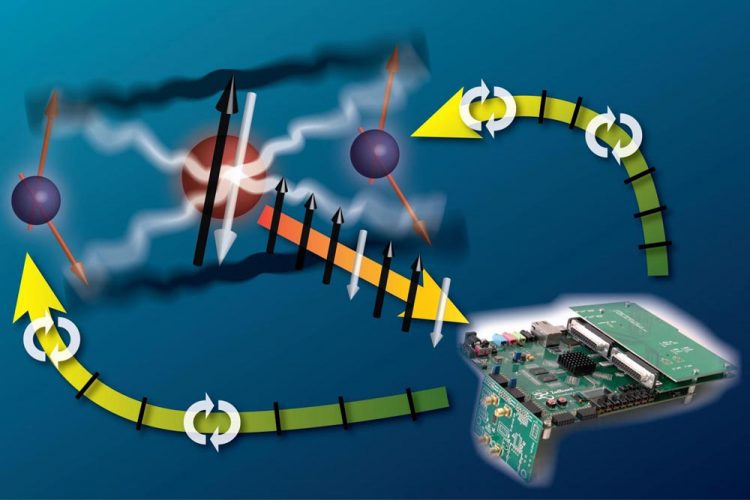Coping with errors in the quantum age

The quantum correlations between two beryllium ions (represented as blue spheres) are sequentially measured using an ancillary calcium ion (red sphere) and stabilized by feedback control through a powerful classical control system (bottom right) that features flexible in-sequence processing. Credit: ETH Zurich / Home group
The field of quantum computation has seen tremendous progress in recent years. Bit by bit, quantum devices start to challenge conventional computers, at least at a handful of selected tasks.
The numerous advances notwithstanding, today's quantum information processors still struggle to cope with errors, which inevitably occur in any calculation. This inability to efficiently rectify errors hinders in turn efforts towards sustained large-scale processing of quantum information.
Hence the excitement for a set of experiments in which the group of Jonathan Home at the Institute for Quantum Electronics integrated for the first time a range of elements needed for performing quantum error correction in a single experiment. These results have been published today in the journal Nature.
Making imperfection tolerable
Just like their classical counterparts, quantum computers are built from imperfect components, and they are far more sensitive to disturbances from the outside. This leads inescapably to errors as calculations are executed.
For conventional computers, there exists a well-established tool kit for detecting and correcting such errors. Quantum computers will rely even more on locating and fixing errors. This requires conceptually different approaches that take into account that information is encoded in quantum states.
In particular, reading out quantum information repeatedly without disturbing it, as is needed for detecting errors, and reacting in real time to reverse these errors pose considerable challenges.
Repeat performance
The Home group encodes quantum information in the quantum states of single ions that are strung together in a trap. Typically, these strings contain ions of only one species. But PhD students Vlad Negnevitsky and Matteo Marinelli, together with postdoc Karan Mehta and further colleagues, have now created strings in which they trapped two different species, two beryllium ions (9Be+) and one calcium ion (40Ca+). Such mixed-species strings have been produced before, but the team used them now in novel ways.
They made use of the distinctly different properties that the two species possess. In particular, in their experiments beryllium and calcium ions are manipulated and measured using very different colours of light. This opens up an avenue for working on one species without disturbing the other.
At the same time, the ETH researchers found ways to let the unlike ions interact with one another in manners that measurements on the calcium ion yield information about the quantum states of the beryllium ions, without corrupting those fragile states.
Importantly, the physicists monitored the beryllium ions repeatedly as they were subjected to imperfections and errors. The team performed 50 measurements on the same system, whereas in previous experiments (where only calcium ions were used) such repeated readout has been limited to only a few rounds.
Corrective action
Spotting errors is one thing, taking action to rectify them another. To do the latter, the researchers developed a powerful control system for repeatedly nudging the beryllium ions depending on how much they strayed away from the target state.
Bringing the ions back on track required complex information processing on the timescale of microseconds. As the system uses classical control electronics, the approach now demonstrated should be useful also for quantum-computation platforms based on information carriers other than trapped ions.
Importantly, Negnevitsky, Marinelli, Mehta and their co-workers demonstrated these techniques can also be used to stabilize states in which the two beryllium ions shared entangled quantum states, which are states that have no direct equivalent in classical physics.
Entanglement is one ingredient that endows quantum computers with unique capabilities. Moreover, these states can also be used to enhance the accuracy of precision measurements. Ingredients for error correction such as the ones now demonstrated can make these states last longer — providing intriguing prospects not only for quantum computation but also for metrology.
Media Contact
All latest news from the category: Physics and Astronomy
This area deals with the fundamental laws and building blocks of nature and how they interact, the properties and the behavior of matter, and research into space and time and their structures.
innovations-report provides in-depth reports and articles on subjects such as astrophysics, laser technologies, nuclear, quantum, particle and solid-state physics, nanotechnologies, planetary research and findings (Mars, Venus) and developments related to the Hubble Telescope.
Newest articles

Photonic chip integrates sensing and computing for ultrafast machine vision
Technology eliminates optical-electronic conversions, holds promise for revolutionizing edge intelligence. Researchers have demonstrated a new intelligent photonic sensing-computing chip that can process, transmit and reconstruct images of a scene within…

Pair plasmas found in deep space can now be generated in the lab
An international team of scientists has developed a novel way to experimentally produce plasma ‘fireballs’ on Earth. Black holes and neutron stars are among the densest known objects in the…

New fabric makes urban heat islands more bearable
With applications in clothing, construction and food storage, the new textile reduces heat from both the sun and thermal radiation from nearby buildings. This year has already seen massive heatwaves…





















